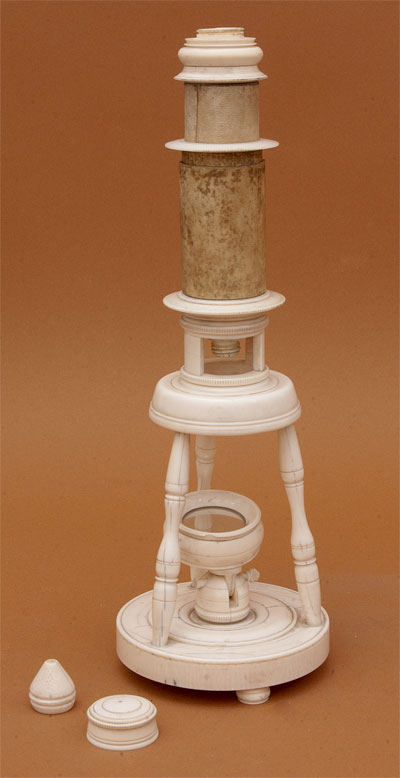 |
|||||
 |
 |
||||
 |
|||||
 |
 |
||||
This is a Nuremberg microscope with the basic construction of the famous Culpeper tripod microscope. It is made almost entirely from ivory, with the exception of draw and body tubes which are constructed of vellum-covered cardboard. The vellum is untooled and unstamped. The microscope itself is supported by a platform and tripod base. Optically, the microscope body consists of a drawtube with a single biconvex eyelens on one end and another biconvex lens mounted in an ivory snout at the other end. The microscope slides into a support structure consisting of an ivory base and cardboard tube. Ivory dust caps can be screwed into the eyepiece collar and objective snout. The field lens should be located at the base of the eyepiece draw tube, but unfortunately it is missing, thus this microscope cannot form an image. The base of the support tube has rectangular cutouts for access to the sample space. A Bonnani spring stage would normally be placed in the cutout space but it too is missing. The microscope assembly and support base fit into a hole in the circular top piece of the base assembly. This piece is supported by three turned ivory legs, which fit into holes in the massive ivory base. The base is supported by squat ivory feet. The position of the feet alternates with the position of the support legs. Samples are illuminated by a large, single-sided plane mirror. The mirror assembly has a mounting tab that fits in a slot in a rotating base. A thin ivory shaft holds the mirror in place.
This popular style, the vellum-covered tripod design, was modeled after the more elegant microscopes by Edmund Culpeper of the early part of the 18th century. The Golub Collection is fortunate to have examples of the three main Nuremberg designed: the Tripod style, the Sentry style (a rectangular drum stand), or a side pillar design. Many of these instruments have initials burnt into the wood base, some surrounded by a circle, some by a heart shape. These may have been the marks of the sellers or distributors of the product. Unfortunately, this ivory tripod instrument in the Golub Collection does not have any such identification. Although some Nuremberg microscopes are said to have been made in the 18th century, it is likely that most were constructed during the first quarter of the 19th century.
Microscope featured 02/2013
